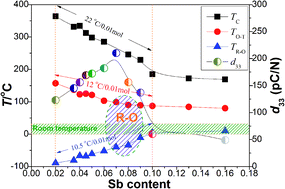Role of antimony in the phase structure and electrical properties of potassium–sodium niobate lead-free ceramics
Abstract
In the past ten years, antimony has been reported to strongly affect the developments in the piezoelectric properties of (K,Na)NbO3 (KNN) lead-free ceramics, that is, its enhanced piezoelectric activity is closely related to the doped antimony as well its content. In this work, we clarified the role of Sb5+ in the construction of a phase structure and the enhancement of electrical properties of a pure KNN ceramic. Research has shown that doping with Sb5+ can simultaneously move their orthorhombic–tetragonal phase transition temperature (TO–T) and rhombohedral–orthorhombic phase transition temperature (TR–O) forward to room temperature, benefiting the formation of three types of phase boundaries. The coexistence of rhombohedral and orthorhombic phases was established in the Sb5+ composition range of 0.07–0.09 by this regulation. In addition, their grain sizes were determined by the Sb5+ content, that is, the optimum Sb5+ content (x ≤ 0.05) induces grain growth, and their grain sizes become considerably smaller when the compositions deviate from x > 0.05. More importantly, their electrical properties could be also tuned by changing the Sb5+ content. Their dielectric, ferroelectric, and piezoelectric properties are strongly dependent on the antimony content, whereas the strain behavior is mainly ascribed to the multi-phase transition region as well as the structural change of phase transitions. As a result, this work would help to further understand the underlying physical origin for enhanced electrical properties in alkali niobate ceramics.


 Please wait while we load your content...
Please wait while we load your content...